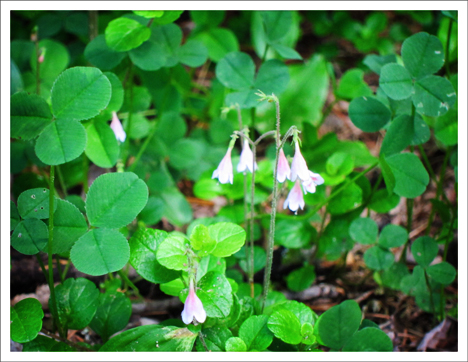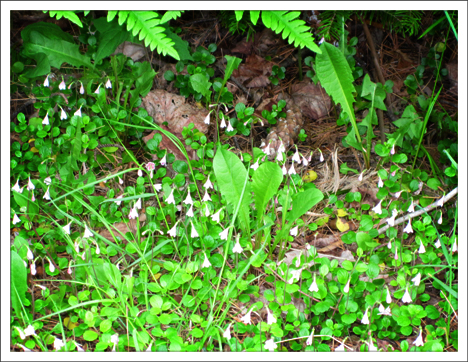Adirondack Wildflowers:
Twinflower (Linnaea borealis)
| This page is no longer being updated. For an updated and expanded version of this material, see: Twinflower (Linnaea borealis) |
 Adirondack Wildflowers: Twinflower blooming at the Paul Smiths VIC (9 June 2012)
Adirondack Wildflowers: Twinflower blooming at the Paul Smiths VIC (9 June 2012)
Twinflower is a miniature evergreen creeping plant that produces pairs of fragrant pink, bell-like flowers in late spring or early summer. Twinflower is a member of the Honeysuckle family. Its trailing stems reach three feet in length.
Twinflower was a favorite flower of the father of modern botany -- Carolus Linnaeus (1707-1778), who was so fond of the plant he had his portrait painted with it. The Latin name (Linnaea) is in honor of him. The term borealis means "northern" -- a reference to the plant's geographic distribution.
Twinflower grows in cool woods and boggy swamps and on mountain slopes throughout the north woods region. It may be found in Canada and the northern third of the US, including upstate New York.
 Adirondack Wildflowers: Twinflower in bloom at the Paul Smiths VIC (8 June 2012)
Adirondack Wildflowers: Twinflower in bloom at the Paul Smiths VIC (8 June 2012)
Twinflower is found on the Barnum Brook Trail at the Paul Smiths VIC. It usually begins blooming in early June at the VIC.
References
- Lady Bird Johnson Wildflower Center. Native Plant Database.
- United States Department of Agriculture. Plants Database.
- Plants for a Future. Database.
- US Forest Service. Celebrating Wildflowers.
- Anne McGrath. Wildflowers of the Adirondacks (EarthWords, 2000), pp. 28,47.
- Doug Ladd. North Woods Wildflowers (Falcon Publishing, 2001), p. 72.
- Lawrence Newcomb. Newcomb's Wildflower Guide (Little Brown and Company, 1977), pp. 284-285.
- Roger Tory Peterson and Margaret McKenny. A Field Guide to Wildflowers. Northeastern and North-central North America (Houghton Mifflin Company, 1968) pp. 236-237.
- William
K. Chapman, et al. Wildflowers of New York in Color (Syracuse
University Press, 1998), pp. 60-61.
